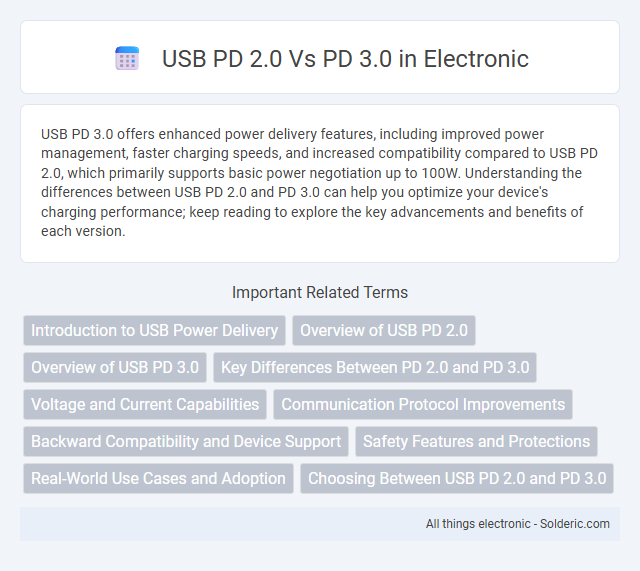USB PD 3.0 offers enhanced power delivery features, including improved power management, faster charging speeds, and increased compatibility compared to USB PD 2.0, which primarily supports basic power negotiation up to 100W. Understanding the differences between USB PD 2.0 and PD 3.0 can help you optimize your device's charging performance; keep reading to explore the key advancements and benefits of each version.
Comparison Table
| Feature | USB Power Delivery 2.0 | USB Power Delivery 3.0 |
|---|---|---|
| Release Year | 2012 | 2015 |
| Max Power Output | 100W (20V, 5A) | 100W (20V, 5A) |
| Improved Power Rules | No | Yes |
| Programmable Power Supply (PPS) | No | Yes |
| Fast Role Swap | No | Yes |
| Data Role Swap | No | Yes |
| Battery Charging Enhancements | Basic | Advanced (optimized charging) |
| Compatibility | Backward compatible with USB PD 1.x | Backward compatible with USB PD 2.0 and 1.x |
Introduction to USB Power Delivery
USB Power Delivery (USB PD) 2.0 and 3.0 are industry standards that enhance power transfer over USB connections by enabling flexible power negotiation up to 100W, improving charging efficiency and device compatibility. USB PD 3.0 introduces advanced features like programmable power supply (PPS) for more precise voltage control, improved power management, and enhanced security protocols to protect against power-related issues. These advancements make USB PD 3.0 ideal for charging a broader range of devices, including laptops and smartphones, with faster and safer charging capabilities compared to USB PD 2.0.
Overview of USB PD 2.0
USB Power Delivery 2.0 offers a flexible charging protocol supporting up to 100W of power transfer with fixed and variable voltage profiles, making it suitable for a wide range of devices from smartphones to laptops. It enables faster charging by allowing devices to negotiate power requirements, enhancing safety and efficiency during power transfer. Your devices leveraging USB PD 2.0 benefit from standardized, high-speed charging, but it lacks some advanced features like extended power ranges and enhanced data communication found in USB PD 3.0.
Overview of USB PD 3.0
USB Power Delivery (PD) 3.0 introduces enhanced power management features compared to PD 2.0, including improved power negotiation and increased flexibility for delivering up to 100W of power. It supports Programmable Power Supply (PPS), enabling more efficient battery charging by allowing dynamic voltage and current adjustments. USB PD 3.0 also enhances security by incorporating built-in authentication to prevent power-related attacks and improve device compatibility.
Key Differences Between PD 2.0 and PD 3.0
USB Power Delivery 3.0 introduces improved power efficiency and enhanced communication protocols compared to USB PD 2.0, supporting up to 100W charging with more precise power negotiation for your devices. PD 3.0 adds Programmable Power Supply (PPS), enabling dynamic voltage and current adjustments that optimize battery charging and reduce heat generation. Security features and better compatibility further distinguish PD 3.0, making it more reliable and versatile for modern electronics.
Voltage and Current Capabilities
USB Power Delivery (PD) 2.0 supports voltage levels of 5V, 9V, 15V, and 20V with a maximum current of 5A, enabling power delivery up to 100W. USB PD 3.0 maintains these voltage and current specifications while adding enhanced communication protocols and improved power rules for more efficient and flexible charging. The voltage and current capabilities of both USB PD 2.0 and PD 3.0 enable fast charging across a variety of devices, but PD 3.0 offers better negotiation and safety features.
Communication Protocol Improvements
USB Power Delivery (PD) 3.0 enhances communication protocols by introducing Programmable Power Supply (PPS), allowing finer voltage and current adjustments for optimized charging efficiency and reduced heat. It incorporates improved error reporting and more robust security features, enabling safer and more reliable power negotiation between devices. These advancements in PD 3.0 facilitate faster charging times and better compatibility across diverse device ecosystems compared to PD 2.0.
Backward Compatibility and Device Support
USB Power Delivery (PD) 3.0 maintains full backward compatibility with USB PD 2.0, allowing devices supporting earlier standards to safely charge and communicate with newer PD 3.0 power sources. PD 3.0 enhances device support by introducing features like Programmable Power Supply (PPS), which allows finer voltage and current adjustments, improving charging efficiency for modern smartphones and laptops. Despite these advancements, PD 3.0 ensures seamless interoperability across a broad range of USB PD-compliant devices, preserving user convenience regardless of device generation.
Safety Features and Protections
USB Power Delivery 3.0 introduces enhanced safety features compared to USB PD 2.0, including improved over-voltage, over-current, and short-circuit protections to better safeguard connected devices. The Programmable Power Supply (PPS) function in USB PD 3.0 allows for more precise voltage and current adjustments, reducing the risk of overheating and extending battery life. USB PD 3.0 also incorporates stricter authentication protocols to prevent unauthorized charging and ensure secure power delivery.
Real-World Use Cases and Adoption
USB PD 3.0 improves real-world use cases by introducing enhanced power negotiation, allowing devices like laptops and smartphones to charge more efficiently and safely with up to 100W power delivery. It supports programmable power supply (PPS), enabling dynamic voltage adjustments that optimize battery health during fast charging, a feature favored by modern flagship devices. Wider adoption of USB PD 3.0 is evident in premium gadgets and peripherals, while USB PD 2.0 remains common in older or budget devices, resulting in varied charging speeds across ecosystems.
Choosing Between USB PD 2.0 and PD 3.0
Choosing between USB PD 2.0 and PD 3.0 depends on your device's power delivery needs and compatibility requirements. USB PD 3.0 offers improved power efficiency, increased communication capabilities with programmable power supply (PPS), and enhanced safety features compared to PD 2.0. If your device supports fast charging and dynamic voltage adjustments, opting for PD 3.0 ensures optimal performance and future-proofing for your charging setup.
USB PD 2.0 vs PD 3.0 Infographic

 solderic.com
solderic.com